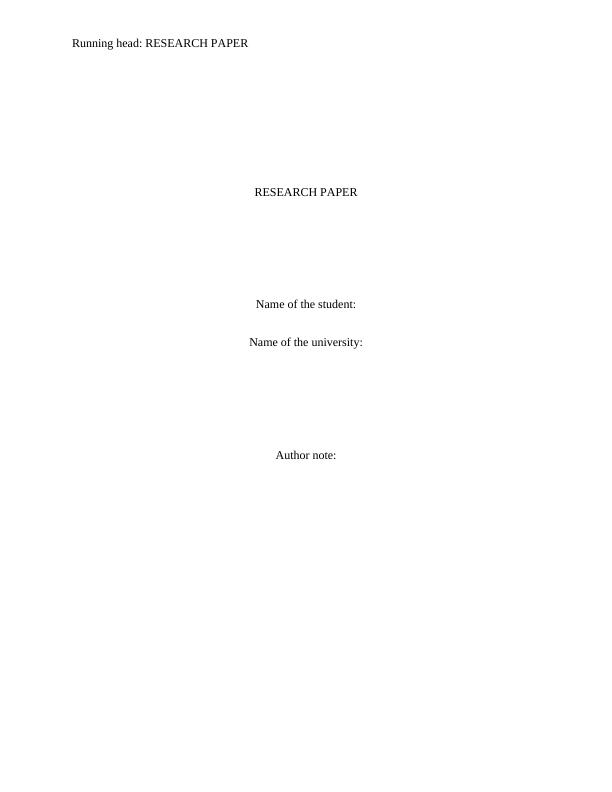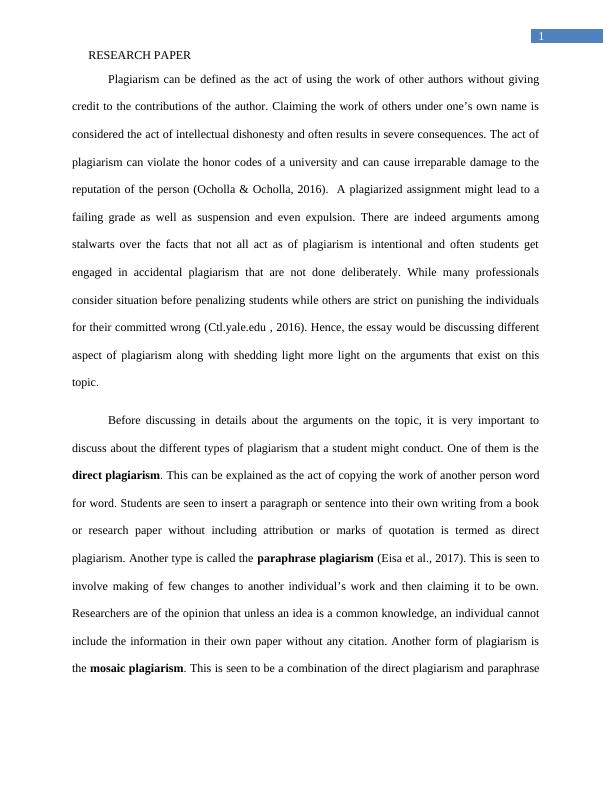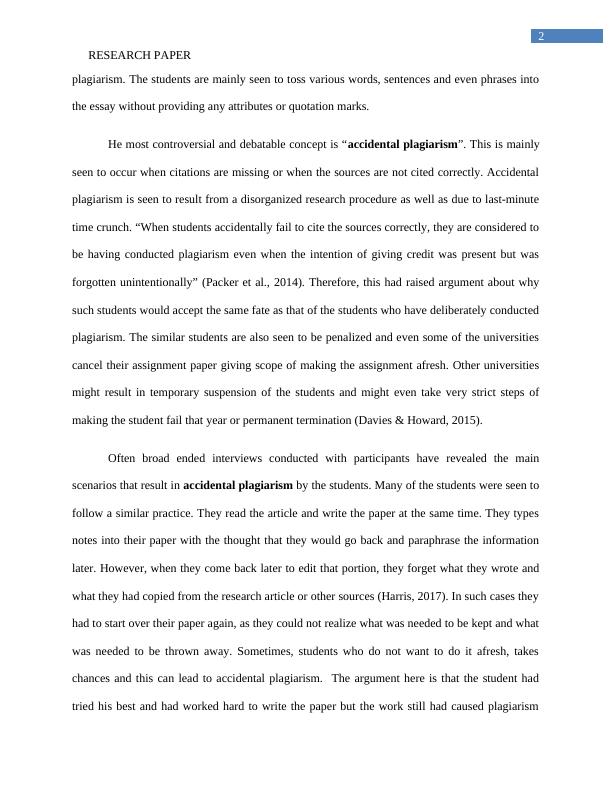Plagiarism in Academic Writing: Understanding the Different Types and Arguments
Added on 2023-05-31
7 Pages1458 Words175 Views
Running head: RESEARCH PAPER
RESEARCH PAPER
Name of the student:
Name of the university:
Author note:
RESEARCH PAPER
Name of the student:
Name of the university:
Author note:

1
RESEARCH PAPER
Plagiarism can be defined as the act of using the work of other authors without giving
credit to the contributions of the author. Claiming the work of others under one’s own name is
considered the act of intellectual dishonesty and often results in severe consequences. The act of
plagiarism can violate the honor codes of a university and can cause irreparable damage to the
reputation of the person (Ocholla & Ocholla, 2016). A plagiarized assignment might lead to a
failing grade as well as suspension and even expulsion. There are indeed arguments among
stalwarts over the facts that not all act as of plagiarism is intentional and often students get
engaged in accidental plagiarism that are not done deliberately. While many professionals
consider situation before penalizing students while others are strict on punishing the individuals
for their committed wrong (Ctl.yale.edu , 2016). Hence, the essay would be discussing different
aspect of plagiarism along with shedding light more light on the arguments that exist on this
topic.
Before discussing in details about the arguments on the topic, it is very important to
discuss about the different types of plagiarism that a student might conduct. One of them is the
direct plagiarism. This can be explained as the act of copying the work of another person word
for word. Students are seen to insert a paragraph or sentence into their own writing from a book
or research paper without including attribution or marks of quotation is termed as direct
plagiarism. Another type is called the paraphrase plagiarism (Eisa et al., 2017). This is seen to
involve making of few changes to another individual’s work and then claiming it to be own.
Researchers are of the opinion that unless an idea is a common knowledge, an individual cannot
include the information in their own paper without any citation. Another form of plagiarism is
the mosaic plagiarism. This is seen to be a combination of the direct plagiarism and paraphrase
RESEARCH PAPER
Plagiarism can be defined as the act of using the work of other authors without giving
credit to the contributions of the author. Claiming the work of others under one’s own name is
considered the act of intellectual dishonesty and often results in severe consequences. The act of
plagiarism can violate the honor codes of a university and can cause irreparable damage to the
reputation of the person (Ocholla & Ocholla, 2016). A plagiarized assignment might lead to a
failing grade as well as suspension and even expulsion. There are indeed arguments among
stalwarts over the facts that not all act as of plagiarism is intentional and often students get
engaged in accidental plagiarism that are not done deliberately. While many professionals
consider situation before penalizing students while others are strict on punishing the individuals
for their committed wrong (Ctl.yale.edu , 2016). Hence, the essay would be discussing different
aspect of plagiarism along with shedding light more light on the arguments that exist on this
topic.
Before discussing in details about the arguments on the topic, it is very important to
discuss about the different types of plagiarism that a student might conduct. One of them is the
direct plagiarism. This can be explained as the act of copying the work of another person word
for word. Students are seen to insert a paragraph or sentence into their own writing from a book
or research paper without including attribution or marks of quotation is termed as direct
plagiarism. Another type is called the paraphrase plagiarism (Eisa et al., 2017). This is seen to
involve making of few changes to another individual’s work and then claiming it to be own.
Researchers are of the opinion that unless an idea is a common knowledge, an individual cannot
include the information in their own paper without any citation. Another form of plagiarism is
the mosaic plagiarism. This is seen to be a combination of the direct plagiarism and paraphrase

2
RESEARCH PAPER
plagiarism. The students are mainly seen to toss various words, sentences and even phrases into
the essay without providing any attributes or quotation marks.
He most controversial and debatable concept is “accidental plagiarism”. This is mainly
seen to occur when citations are missing or when the sources are not cited correctly. Accidental
plagiarism is seen to result from a disorganized research procedure as well as due to last-minute
time crunch. “When students accidentally fail to cite the sources correctly, they are considered to
be having conducted plagiarism even when the intention of giving credit was present but was
forgotten unintentionally” (Packer et al., 2014). Therefore, this had raised argument about why
such students would accept the same fate as that of the students who have deliberately conducted
plagiarism. The similar students are also seen to be penalized and even some of the universities
cancel their assignment paper giving scope of making the assignment afresh. Other universities
might result in temporary suspension of the students and might even take very strict steps of
making the student fail that year or permanent termination (Davies & Howard, 2015).
Often broad ended interviews conducted with participants have revealed the main
scenarios that result in accidental plagiarism by the students. Many of the students were seen to
follow a similar practice. They read the article and write the paper at the same time. They types
notes into their paper with the thought that they would go back and paraphrase the information
later. However, when they come back later to edit that portion, they forget what they wrote and
what they had copied from the research article or other sources (Harris, 2017). In such cases they
had to start over their paper again, as they could not realize what was needed to be kept and what
was needed to be thrown away. Sometimes, students who do not want to do it afresh, takes
chances and this can lead to accidental plagiarism. The argument here is that the student had
tried his best and had worked hard to write the paper but the work still had caused plagiarism
RESEARCH PAPER
plagiarism. The students are mainly seen to toss various words, sentences and even phrases into
the essay without providing any attributes or quotation marks.
He most controversial and debatable concept is “accidental plagiarism”. This is mainly
seen to occur when citations are missing or when the sources are not cited correctly. Accidental
plagiarism is seen to result from a disorganized research procedure as well as due to last-minute
time crunch. “When students accidentally fail to cite the sources correctly, they are considered to
be having conducted plagiarism even when the intention of giving credit was present but was
forgotten unintentionally” (Packer et al., 2014). Therefore, this had raised argument about why
such students would accept the same fate as that of the students who have deliberately conducted
plagiarism. The similar students are also seen to be penalized and even some of the universities
cancel their assignment paper giving scope of making the assignment afresh. Other universities
might result in temporary suspension of the students and might even take very strict steps of
making the student fail that year or permanent termination (Davies & Howard, 2015).
Often broad ended interviews conducted with participants have revealed the main
scenarios that result in accidental plagiarism by the students. Many of the students were seen to
follow a similar practice. They read the article and write the paper at the same time. They types
notes into their paper with the thought that they would go back and paraphrase the information
later. However, when they come back later to edit that portion, they forget what they wrote and
what they had copied from the research article or other sources (Harris, 2017). In such cases they
had to start over their paper again, as they could not realize what was needed to be kept and what
was needed to be thrown away. Sometimes, students who do not want to do it afresh, takes
chances and this can lead to accidental plagiarism. The argument here is that the student had
tried his best and had worked hard to write the paper but the work still had caused plagiarism

End of preview
Want to access all the pages? Upload your documents or become a member.
Related Documents
Professional skills for Business and Finance (pdf)lg...
|6
|1372
|73
Plagiarism in Business Context: Concept, Relevance, and Consequenceslg...
|6
|1296
|23
Plagiarism and Referencinglg...
|2
|1631
|412
Uphold Academic Integrity: How to Avoid Plagiarismlg...
|2
|860
|64
What is Plagiarism?lg...
|10
|541
|33
Plagiarism in Academic Writing and Professionalismlg...
|6
|1249
|83
